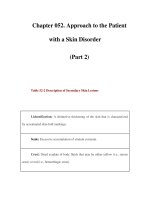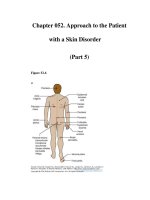Chapter 052. Approach to the Patient with a Skin Disorder (Part 2) potx
Bạn đang xem bản rút gọn của tài liệu. Xem và tải ngay bản đầy đủ của tài liệu tại đây (29.3 KB, 5 trang )
Chapter 052. Approach to the Patient
with a Skin Disorder
(Part 2)
Table 52-2 Description of Secondary Skin Lesions
Lichenification: A distinctive thickening of the skin that is characterized
by accentuated skin-fold markings.
Scale: Excessive accumulation of stratum corneum.
Crust: Dried exudate of body fluids that may be either yellow (i.e., serous
crust) or red (i.e., hemorrhagic crust).
Erosion: Loss of epidermis without an associated loss of dermis.
Ulcer: Loss of epidermis and at least a portion of the underlying dermis.
Excoriation: Linear, angular erosions that may be covered by crust and are
caused by scratching.
Atrophy: An acquired loss of substance. In the skin, this may appear as a
depression with intact epidermis (i.e., loss of dermal or subcutaneous tissue) or as
sites of shiny, delicate, wrinkled lesions (i.e., epidermal atrophy).
Scar: A change in the skin secondary to trauma or inflammation. Sites may
be erythematous, hypopigmented, or hyperpigmented depending on their age or
character. Sites on hair-bearing areas may be characterized by destruction of hair
follicles.
Table 52-3 Common Dermatologic Terms
Alopecia: Hair loss; it may be partial or complete.
Annular: Ring-shaped lesions.
Cyst: A soft, raised, encapsulated lesion filled with semisolid or liquid
contents.
Herpetiform: Grouped lesions.
Lichenoid: Violaceous to purple, polygonal lesions that resemble those
seen in lichen planus.
Milia: Small, firm, white papules filled with keratin.
Morbilliform: Generalized, small erythematous macules and/or papules
that resemble lesions seen in measles.
Nummular: Coin-shaped lesions.
Poikiloderma: Skin that displays variegated pigmentation, atrophy, and
telangiectases.
Polycyclic: A configuration of skin lesions formed from coalescing rings or
incomplete rings.
Pruritus: A sensation that elicits the desire to scratch. Pruritus is often the
predominant symptom of inflammatory skin diseases (e.g., atopic dermatitis,
allergic contact dermatitis); it is also commonly associated with xerosis and aged
skin. Systemic conditions that can be associated with pruritus include chronic
renal disease, cholestasis, pregnancy, malignancy, thyroid disease, polycythemia
vera, and delusions of parasitosis.
Figure 52-3
A schematic representation of several common primary skin lesions
(see Table 52-1).









